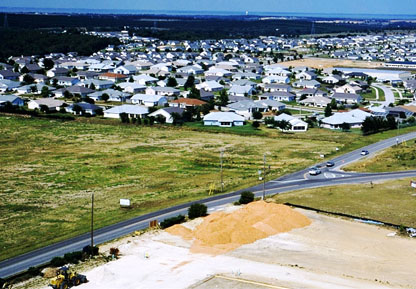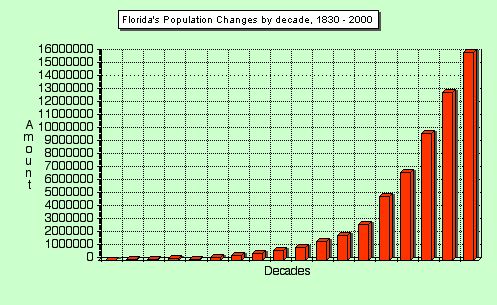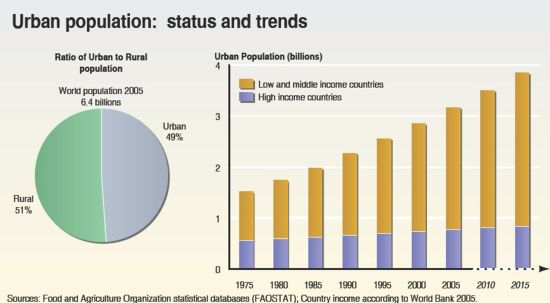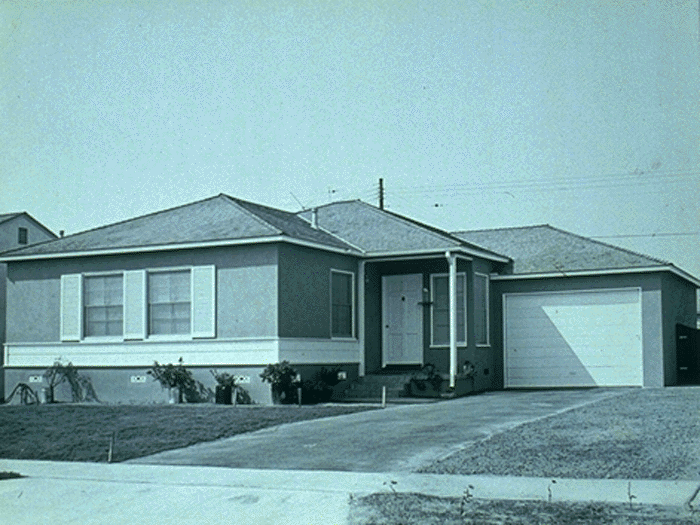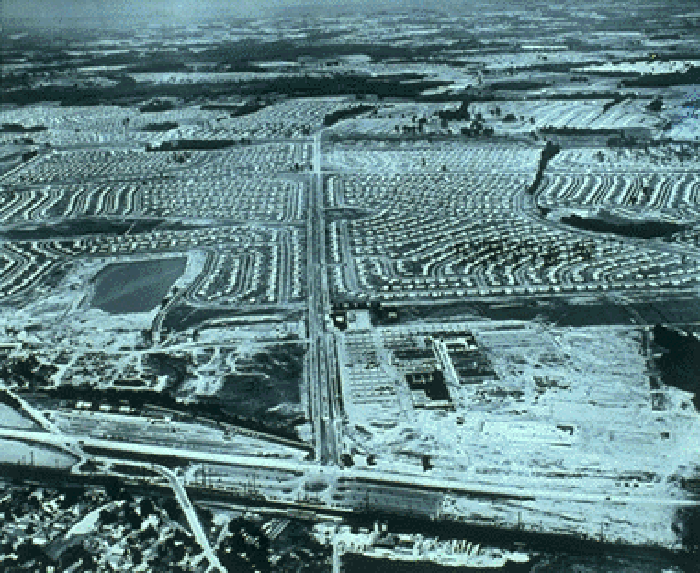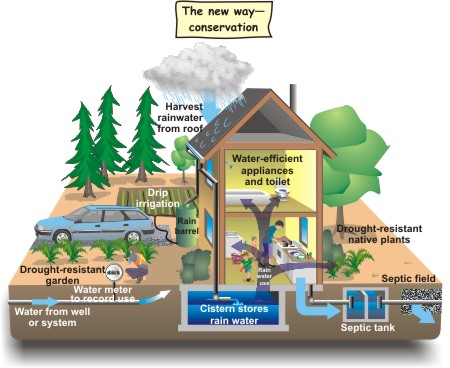 Bull Dozer's a coming
Bull Dozer's a coming  Part I
Part I 
What enabled suburbs to dominate the politics, culture & landscape of our cities?
"...the sprawl of suburbia an environmental disaster–" Bulldozer. p. 3.
NRDC file photo, 2001.Bulldozer in the Countryside: Suburban Sprawl and the Rise of American Environmentalism, 2001. Adam Rome.
“The environmental cost of home building rose sharply after 1945.”
p. xi.
There are, as outlined in the Adam Rome book, steps that federal policy took enabling the 1945 to 2005 boom in suburban housing. The costs directly were a loss of farms, orchards, topsoil and wildlife and indirectly it made children fat, cars a necessity; it overcrowded schools, congested the inadequate roads, and generated soaring municipal expenditures while the urban tax base was so eroded that services in cities declined. Suburbs struggled to keep up with schools, sanitation, roads and police or fire protection. A rendition of the explosive growth of suburbia in the decades following World War II is what the bulldozer stands for as it moves ever so noisily through our countryside performing the ultimate make-over.
J. Siry, Commentary on The Bulldozer in the Countryside.
How the policy for housing promoted a boom, at first in all cities and then the "Sun-belt."
The Federal Housing Administration, the G. I. Bill, and the National Defense Highway Act worked together that not merely changed the face of the nation's urban "city-scape," but in making home ownership a reality for a wider number of Americans, simultaneously promoted a way of life that used more land per capita, required more water per household and intensified our use of fossil fuels.
urban, designating residential, commercial, and municipal dwellings within the limits of cities.
suburban, designating residential, commercial, and municipal dwellings not within large city-limits
standard metropolitan statistical areas
bipolarity, the existence of differing extremes in the same individual or context.
orange tinted areas on the map are big cities while encircling yellow and amber are suburban areas
"tract-house construction" and "suburban development" interchangeably in the text but they can imply subtle and significant differences:
"I use 'tract house construction' and 'suburban development' interchangeably, but I recognize that the two phrases are not strictly synonymous. Many tract-house subdivisions lay within the borders of large cities. Because mass building required large and inexpensive tracts of land, however, the great majority of the homes built after World War II were in suburbs – the communities surrounding long-established urban centers."
pp. xii-xiii.
By the 1960s Cities had become overlooked, business backwaters, unfashionable, financially strapped, burdened by expenditures for services to part-time commuters and transport systems to the exurbs they served; having become urban wastelands residents of the downtown core lived only to see surrounding suburbs become the primary residence of most Americans by 1973.
By 1972 half of the urban population of the United States was actually suburban, that is; living outside of the central core of cities. Cities had become in 1920 the residence of half the nation's people. But by the 1950s that pattern began to change.
1950: Lakewood Park, California.
A new home, one of a type being built in Lakewood Park, a new community housing development in southern California. All homes are equipped with the following: garbage pulverizer, double sink, stainless steel drainboard, painted wall shades. Kitchens have inlaid linoleum and bathrooms are equipped with rubber tile. All homes have either one or two-car garages. Gardens are dug over and a tree is planted in front of each house. Front and side lawns and shrubs are provided. Lakewood Park has been called by some the largest community housing development in history. When finished, it will have a total of 17,150 homes.
"Lakewood Park exemplified a revolutionary new way of building, and the developers took great pride in the project."
Lakewood, California, 1950s.
"The world's largest planned housing development...."
Rome, Bulldozer in the Countryside, pp. 1-2.
"For the first time, builders put hundreds of thousands of homes in environmentally sensitive areas, including wetlands, steep hillsides, and floodplains. Builders also began to use new earth-moving equipment to level hills, fill creeks, and clear vegetation from vast tracts.
Ibid, p. 3.
"The promise to fulfill the dreams of countless couples added up to a promise to transform the country....the construction of millions of new homes would only be a part of the postwar effort to to achieve permanent prosperity. The hard times of the 1930s would never return. Soon the nation would be rebuilt, almost reborn."
40
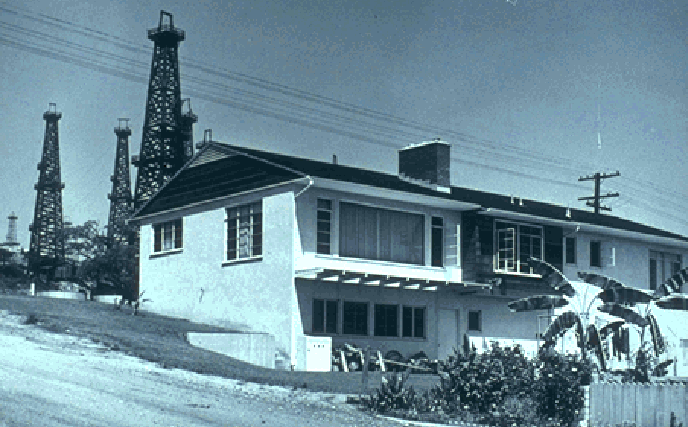 Signal Hill, California, 1950s, the sight in 1920s of a major oil discovery. Set on 2.2 square miles of land the city of Signal Hill is at once a suburb and an historical place. Where oil derricks and tract homes were constructed side by side as if to suggest the inherent link between use of fossil fuels and live in a home of one's own.
Signal Hill, California, 1950s, the sight in 1920s of a major oil discovery. Set on 2.2 square miles of land the city of Signal Hill is at once a suburb and an historical place. Where oil derricks and tract homes were constructed side by side as if to suggest the inherent link between use of fossil fuels and live in a home of one's own.
Representing the epitome of progress the modern home situated here beside the sloping road is also set amidst the very structures needed to maintain the autonomy of location; namely electrical utility poles and oil wells. The electricity facilitates functionality of the suburban homes use of water, lighting and appliances while the petroleum literally made highways and fueled the cars that provided access to the maze of single family home-lined streets.
Signal Hill was previously known for its oil drills and derricks that rose to the sky, and in fact, evidence of knowledge of oil and tar appear in its earliest history. Crude that welled up naturally was used for a variety of purposes.
In 1922 a gusher of oil that took four days to cap was greeted by the cheers of a crowd that gathered to watch. Several years later in 1924 the City of Signal Hill was incorporated. Ranches and mansions quickly disappeared from the area and were replaced with a forest of oil towers on "Porcupine Hill". Roads were paved, refineries sprang up, fires raged and were extinguished and some people became wealthy almost overnight. Because of oil production, land which normally would have been prime property for housing was held at bay during the city's 75+ years of oil yields.
"Big campaign money buys special access. . . "
John Dean, Worse than Watergate. p. 76.

![]()
"a significant consequence of widespread suburbanization meant that more oil was used to heat homes, or get to work, school, shopping and recreation areas. The oil companies and electric utilities made fortunes, on the zest for single family home ownership."
J. Siry, 1984.
"I found abundant evidence that the environmental cost of home building rose sharply after 1945."
p. xi.
The first sign of revisionism came in a 1964 book, Peter Blake's God's Own Junkyard. The book was a biting pictorial attack on 'the planned deterioration of America's landscape. . . . The suburbs were wastelands."
1969: "For Nathaniel Owings, the bulldozed landscape was an object lesson in 'what we want to avoid.' Now we needed to 'salvage what we have damaged' and 'save what is still unspoiled.' We need to build communities that would 'thrive in harmony with the land.' "
Adam Rome, Bulldozer in the Countryside.
- Introduction.
- 1. Levitt’s progress: the rise of the suburban-industrial complex.
- 2. From the solar house to the all-electric home: the postwar debates over heating & cooling.
- 3. Septic-tank suburbia: the problem of waste disposal at the metropolitan fringe.
- 4. Open space: the first protests against the bulldozed landscape.
- 5. Where not to build: the campaigns to protect wetlands, hillsides, and floodplains.
- 6. Water, soil, and wildlife: the federal critiques of tract-house development.
- 7. Toward a land ethic: the quiet revolution in land-use regulation.
- Conclusion.
William Levitt, founder of Levittown made the cover of Time magazine.
Photo from the National Portrait Gallery, Washington D. C.
Essay
Despite a century efforts to conserve natural resources since 1909, much of the advances gained by soil conservation and wildlife and fisheries protection would by 1945 face a most serious and enduring challenge as it came not from a foreign enemy but from within.
The Bulldozer in the Countryside is a scholarly history of efforts to identify, publicize, and reduce the environmental costs of suburban development in the United States. The book offers a new account of two of the most important historical events in the period since World War Two–the mass migration to the suburbs and the rise of the environmental movement. This work offers a valuable historical perspective for seeing how the issue of suburban sprawl was recognized early in the 1950s and the origins of environmentalism in the Open Space efforts reveal clearly what the consequences of this revolution in mass produced dwellings fostered a technological shift in the use of building materials, that really entailed both extensive direct and expensive indirect consequences on land-use, water consumption, and energy waste.
The loss of land, water, air quality and wildlife to the single-family tract home over the last seventy-five years has also had consequences for the rapid decline in biological diversity. Now this little appreciated ecological value inherent in natural areas to varying degrees is seen to have an impact on human well-being.
"In an era of human health defined by multiple threats, biodiversity remains a critical piece to promoting well-being. In this week's post to the MAHB Blog, Holly Moeller explores the relationship between biodiversity loss and human health, specifically how the destruction of biodiversity may be eliminating natural reservoirs of medicines before we even know their value."
Thus as Holly Moeller writes in "Doctor Nature: How our health hinges on biodiversity," Holly Moeller | April 7, 2015 | MAHB, Stanford University, our very lives depend upon the biological diversity we are destroying.
So retrospectively it was said by Charles Abrams in 1946, housing was the cause of the great depression "as well as retarding recovery," due to the widespread and "notorious backwardness of the housing industry."
p.33.
"Progress is our most important product."
GE advertising in 1960s
To hasten the industrialization of homebuilding...a massive program of public construction.
The Housing Act of 1949
"The amendments also liberalized (eased credit) the terms of the FHA loan program.
The legislation worked. In the late 1940s and 1950s home ownership skyrocketed, topping 60% by 1956."
In twenty short, prosperous years a shift in national appetites that devoured a million acres of land every year had become evident:
"…reflected a dramatic change in the way many Americans reckoned the costs and benefits of suburban development."
"The problems did not become apparent all at once. Thought the postwar building boom was an environmental catastrophe on the scale of the Dust Bowl, the signs of trouble were not nearly so striking as the 1930s."
"The story begins with the postwar revolution in construction. The adoption of mass production techniques greatly intensified the environmental impact of homebuilding."
"The ranch house became the norm in places as diverse as Minnesota, Arizona, Florida, and Kansas -- and residential use of energy skyrocketed."
p. 3.
Homes meant electrical, gas, or oil heating and air conditioning.
Colorado: the wild, wild best.
Bulldozer part three: Open space & Wetlands' protection.
Bulldozer part four: Revolt, the Quiet Revolution and Rebellion.
Aldo Leopold and a re-envisioning of the landscape.
Merchant's Chronology 1640-1992.
16 November 2007, 31 March 2012, & April 5, 2015


